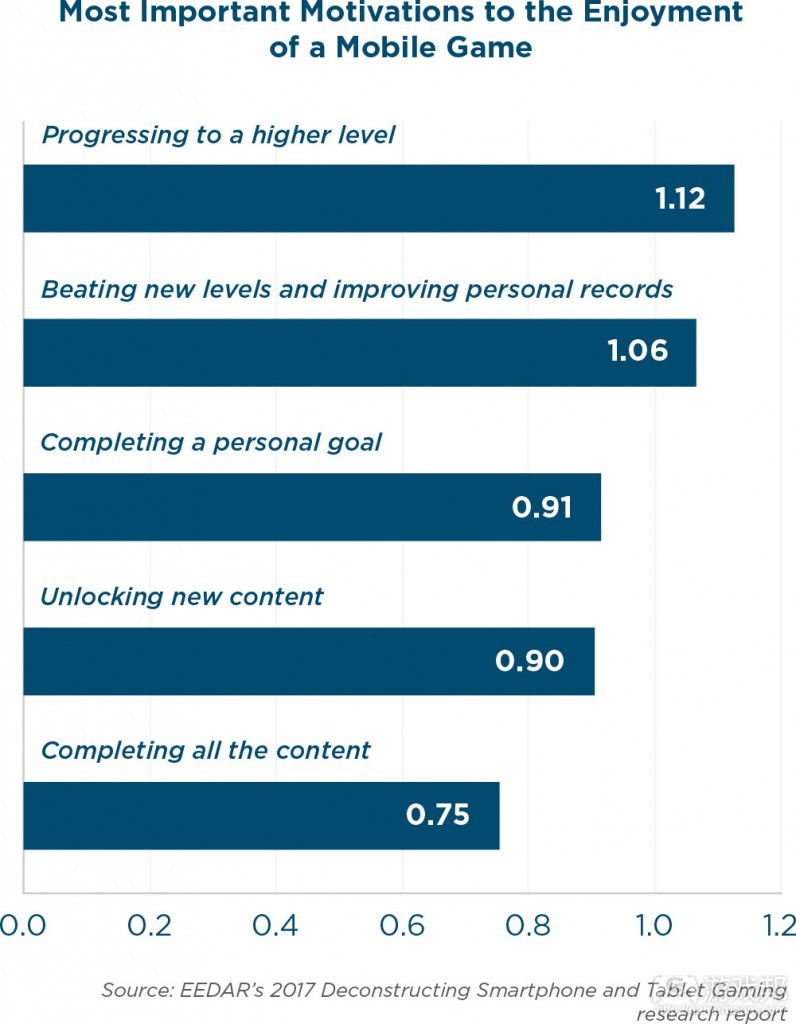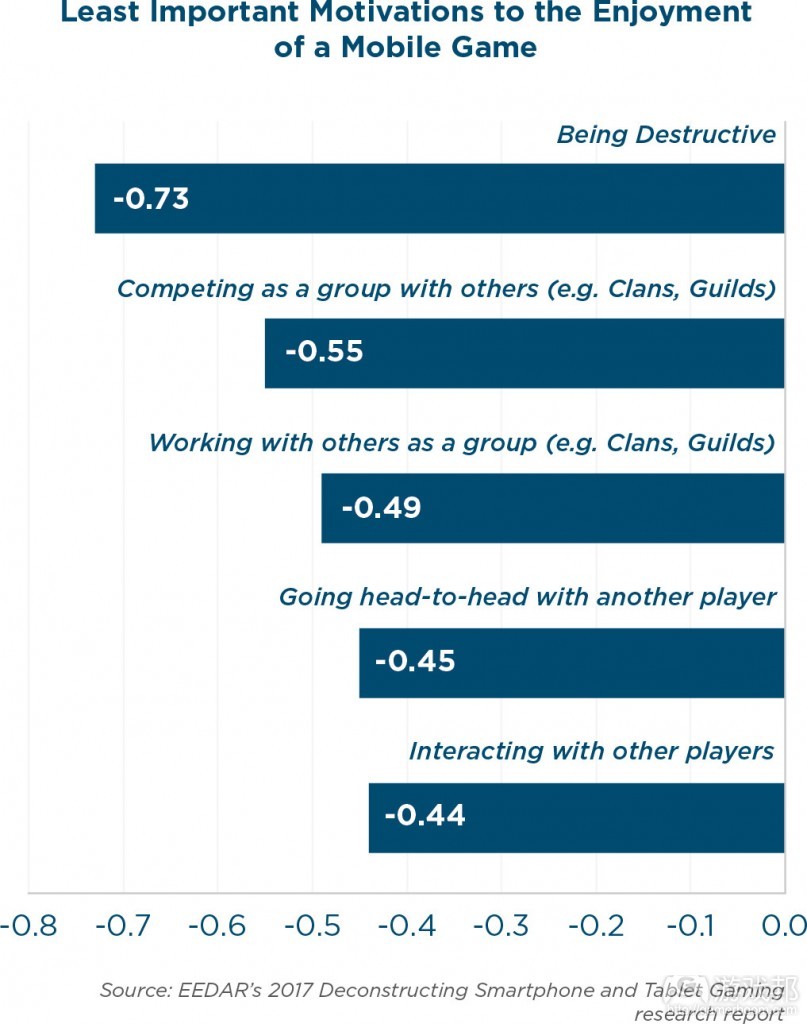以Monster Strike的不适应为例如何吸引北美地区的手游玩家?
以Monster Strike的不适应为例如何吸引北美地区的手游玩家?
原作者:Heather Nofziger 译者:Willow Wu
当你在为游戏的全球发行进行设计、本地化时,你必须要知道它到底合不合当地玩家的胃口。
就比如日本手游《怪物弹珠》(Monster Strike),它在本土市场大获成功,但在其他国家就不是那么顺利了——这就是因为它的游戏体验无法引起这些新用户的共鸣。
为了让大家了解北美地区的玩家对各类手游的看法,EEDAR分析了33中不同的游戏玩法以及动机。
反馈数据来源于3000名成人以及1000名青少年,EEDAR要求他们依照个人兴趣对33种游戏玩法进行评分,这些玩法与竞赛、合作、挑战、沉浸感、策略、定制、进阶成就、以及完成度有关。通过了解北美玩家最喜欢/最不喜欢的玩法,开发者们对于什么样游戏元素能在市场上大受欢迎就有了更加明确的了解。
就北美手游市场而言,包含进阶、(任务/剧情)完成需求、以及成就系统的单人游戏模式最能吸引玩家。
由此也不难看出让北美活跃手游玩家持续玩下去的动力就是获得关卡进阶以及提升他们之前的游戏成绩。但是问题在于为什么?
在分析游戏中应用最广泛、最有效的动机设定时,前十中有八种都涉及到了进阶、(任务/剧情)完成需求、以及成就系统这三大meta元素。任何与它们有关的设计都不会引起玩家的反感(在反馈数据中也没有玩家打零分)。
与之相反,涉及到多人模式(不管是竞争还是合作)或者是游戏内社交互动的玩法并不能有效地促使玩家玩下去。事实上,它们的评分在33种玩法体验中是比较靠后的。
这并不是说倚重多人模式的游戏在北美地区就找不到喜欢它的玩家(像《皇室战争》就是个有力的反驳证据),但是潜在玩家数量真的没有那么多——除非游戏团队能够做出明智的市场选择。EEDAR的研究显示高达100%的北美玩家会对进阶/成就相关的设计元素反应积极,而只有30%的玩家会专注于多人玩法。
以多人模式为主的手游要提高玩家沉浸度、实现成功需要谨慎地结合一些可量化的进阶设计元素,帮助玩家设定个人目标,并且奖励玩家的个人成就。适当着重这些元素可以帮助开发者们吸引更多玩家,尤其是那些对竞争玩法不太感兴趣的玩家。
《皇室战争》的核心是竞争性的多人玩法,但是玩家可以通过竞技场来提升个人技能、实现进阶,这种区别就是广泛吸引北美玩家的关键所在。
本文由游戏邦编译,转载请注明来源,或咨询微信zhengjintiao
When designing or localizing your mobile game for international release, it is critical to examine whether or not it’s a good fit for what people in local markets want to play on their mobile devices.
As we’ve seen with megahits like Japan’s Monster Strike, what achieves overwhelming success in one country might falter when released in another — simply because it’s offering an experience that doesn’t resonate with what the new audience is looking for.
To provide a better understanding of how and why North American players play mobile games, EEDAR examined player interest in 33 different types of gameplay experiences and motivations.
Response data for this analysis comes from 3,000 adults and 1,000 teenagers who were asked to rate their interest in 33 mobile gameplay experiences that included elements associated with competition, cooperation, challenge/excitement, immersion, strategy, customization, progression achievement, and completion. These ratings were then ranked by most – and least – compelling gameplay motivations for the North American mobile market to give insight into what factors are most appealing at a market level.
When it comes to mobile gaming in North America, single-player experiences associated with progression, completion, and achievement most consistently drive play.
Looking at these motivations, it’s easy to see that active mobile gamers in North America are motivated by moving through a game’s levels and improving upon their previous performances. The key question, however, is why?
In analyzing the strongest and most common motivations, it’s important to note that 8 out of the top 10 all roll up under three motivational metafactors: Progression, Achievement, and Completion. All elements associated with these factors were generally seen as positive by mobile gamers (rating over 0 in all cases).
By contrast, motivations relating to multiplayer (whether competitive or cooperative) or in-game social interactions appear nowhere in the top 10. In fact, they rank much closer to the bottom of the battery of 33 gameplay experiences.
This is not to say that games which rely heavily on multiplayer cannot find an audience in North America (titles such as Clash Royale provide evidence to the contrary), but it suggests that games that leverage this approach will be more limited in their potential audience overall – unless they make intelligent choices about the market they’re launching into. EEDAR’s research suggests that, where essentially 100% of NA gamers will respond favorably to elements that push them to Progress and/or Achieve, only 30% or so are going to be specifically interested in engaging with other players.
Driving engagement and success with a predominantly multiplayer experience on mobile, then, requires careful incorporation of elements that show quantifiable progression, help players to set personal goals, and reward individual achievement. Emphasizing these elements will help attract a broader audience who is less interested in competition.
The core of Clash Royale’s gameplay may be built around competitive multiplayer, but players can make and appraise meaningful single-player progress as they advance through arenas. This distinction is key to reaching the broadest amount of mobile gamers in North America.(source:venture beat )









































 闽公网安备35020302001549号
闽公网安备35020302001549号